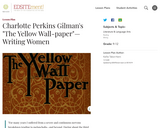
This unit walks students through a variety of activities revolving around George Orwell's book '1984'.
- Subject:
- English Language Arts
- Material Type:
- Unit of Study
- Provider:
- Michigan Virtual
- Author:
- Abby Perdok
- Date Added:
- 06/28/2017

This unit walks students through a variety of activities revolving around George Orwell's book '1984'.

This collection uses primary sources to explore The Absolutely True Diary of a Part-Time Indian by Sherman Alexie. Digital Public Library of America Primary Source Sets are designed to help students develop their critical thinking skills and draw diverse material from libraries, archives, and museums across the United States. Each set includes an overview, ten to fifteen primary sources, links to related resources, and a teaching guide. These sets were created and reviewed by the teachers on the DPLA's Education Advisory Committee.

The true tale of the Recycled Orchestra of Paraguay, an orchestra made up of children playing instruments built from recycled trash. The resources includes a lesson plan/book card, a design challenge, and copy of a design thinking journal that provide guidance on using the book to inspire students' curiosity for design thinking. Maker Challenge: Students will create their own musical instruments with recyclable materials.
A document is included in the resources folder that lists the complete standards-alignment for this book activity.

The Folger Shakespeare Library provides the full searchable text of "All's Well That Ends Well" to read online or download as a PDF. All of the lines are numbered sequentially to make it easier and more convenient to find any line.

This course studies the national literature of the United States since the early 19th century. It considers a range of texts - including, novels, essays, and poetry - and their efforts to define the notion of American identity. Readings usually include works by such authors as Nathaniel Hawthorne, Henry David Thoreau, Frederick Douglass, Emily Dickinson, and Toni Morrison.

The Folger Shakespeare Library provides the full searchable text of "As You Like It" to read online or download as a PDF. All of the lines are numbered sequentially to make it easier and more convenient to find any line.

The Folger Shakespeare Library provides the full searchable text of "All's Well That Ends Well" to read online or download as a PDF. All of the lines are numbered sequentially to make it easier and more convenient to find any line.

Tony Sarg was a puppeteer and marionette master who invented the first, larger than life, helium balloons for the annual Macy’s Thanksgiving Day Parade. The resource includes a lesson plan/book card, a design challenge, and copy of a design thinking journal that provide guidance on using the book to inspire students' curiosity for design thinking. Maker Challenges include: (1) Dash/Sphero: Develop a Macy’s Day Parade route using tape on the ground with a partner. Then, switch routes with another group and program the robot of your choice to navigate the parade route using code. (2) Ozobot: Develop a synchronized dance routine for both Ozobots for the stage of the Macy’s day parade using https://ozoblockly.com/editor (3) Create a moveable puppet that will be featured in the Macy’s Day Parade.
A document is included in the resources folder that lists the complete standards-alignment for this book activity.

The true, inspiring story of Beauty, the bald eagle, who was shot, rescued, and received a 3D-printed prosthetic beak. The resource includes a lesson plan/book card, a design challenge, and copy of a design thinking journal that provide guidance on using the book to inspire students' curiosity for design thinking. Maker Challenges: (1) Use paper and pencil to design a prosthetic body part for a human or animal. Then use tinkercad.com to create a prototype. Finally, use a 3D printer to print the prosthetic. (2) Have students research animals who use prosthetics. Then, improve the design in Tinkercad and 3D Print.
A document is included in the resources folder that lists the complete standards-alignment for this book activity.

In this lesson, students will investigate Dylan as poet by comparing the literary structure of "Subterranean Homesick Blues" and Allen Ginsberg's poem "Howl." They will investigate the differences between poetry and song and examine the similarities between the two in terms of textual structure and style, using their analyses to write original extensions of the poem or song.

In this lesson, students will discuss how the ideals of the Harlem Renaissance and Locke's New Negro were exemplified by the poetry of Langston Hughes. Specifically, they will examine how Hughes incorporated the vernacular tradition of the Blues in his work, and identify the literary techniques Hughes employs to make his poetry so vivid.

Using scrap metal and spare parts, William Kamkwamba created a windmill to harness the wind and bring electricity and running water to his Malawian village. The resource includes a lesson plan/book card, a design challenge, and copy of a design thinking journal that provide guidance on using the book to inspire students' curiosity for design thinking. Maker Challenge: Develop a way to harness the wind by designing with Strawbees.
A document is included in the resources folder that lists the complete standards-alignment for this book activity.

Ralph Baer’s family fled Nazi Germany for the US when he was a child. Using wartime technology, Baer thought outside the box and transformed the television into a vehicle for gaming. His invention was the birth of the first home console, the Odyssey, a precursor to the Atari gaming system. The resource includes a lesson plan/book card, a design challenge, and copy of a design thinking journal that provide guidance on using the book to inspire students' curiosity for design thinking. Maker Challenges: (1) Think outside the box. What’s something you use everyday, but not for its “intended” purpose? Examples: A broom to clean the snow off your car windshield, a trash bag as a sled. Now, think of a problem you might have at school, home, et al. Invent an item that would solve this problem. (2) Let’s think outside the box! Design the latest and greatest technology for kids to hit the market! Make it the *most* fun anyone has ever had. You may NOT use anything on the market - any technology currently on the market is off limits. Use your imagination, do not put limitations on it, and be as creative as you can. (3) Use household items to create a prototype of your new invention.
A document is included in the resources folder that lists the complete standards-alignment for this book activity.

Using the landmark feminist short story "The Yellow Wall-paper," students will employ close reading concepts to analyze setting, narrative style, symbol, and characterization.

This lesson provides a Common Core application for high school students for Chinua Achebe's novel Things Fall Apart. Students will undertake close reading of passages in Things Fall Apart to evaluate the impact of Achebe's literary techniques, the cultural significance of the work, and how this international text serves as a lens to discover the experiences of others.

It’s easy to take today’s ubiquitous colored crayons for granted, but they were the result of one individual’s innovation. Biebow introduces Edwin Binney—a mustachioed man and head of a carbon black factory—who wished to make color-pigmented wax crayons that reflected the world outside. The resource includes a lesson plan/book card, a design challenge, and copy of a design thinking journal that provide guidance on using the book to inspire students' curiosity for design thinking. Maker Challenge: Think about the school/community/world in which you live and identify a problem that could be solved with a new invention.
A document is included in the resources folder that lists the complete standards-alignment for this book activity.

Huckleberry Finn opens with a warning from its author that misinterpreting readers will be shot. Despite the danger, readers have been approaching the novel from such diverse critical perspectives for 120 years that it is both commonly taught and frequently banned, for a variety of reasons. Studying both the novel and its critics with an emphasis on cultural context will help students develop analytical tools essential for navigating this work and other American controversies. This lesson asks students to combine internet historical research with critical reading. Then students will produce several writing assignments exploring what readers see in Huckleberry Finn and why they see it that way.

By closely reading historical documents and attempting to interpret them, students consider how Arthur Miller interpreted the facts of the Salem witch trials and how he successfully dramatized them in his play, "The Crucible." As they explore historical materials, such as the biographies of key players (the accused and the accusers) and transcripts of the Salem Witch trials themselves, students will be guided by aesthetic and dramatic concerns: In what ways do historical events lend themselves (or not) to dramatization? What makes a particular dramatization of history effective and memorable?

We are naturally curious about the lives (and deaths) of authors, especially those, such as Edgar Allan Poe and Ambrose Bierce, who have left us with so many intriguing mysteries. But does biographical knowledge add to our understanding of their works? And if so, how do we distinguish between the accurate detail and the rumor; between truth and exaggeration? In this lesson, students become literary sleuths, attempting to separate biographical reality from myth. They also become careful critics, taking a stand on whether extra-literary materials such as biographies and letters should influence the way readers understand a writer's texts.

Students will view this slideshow online as the first activity in a blended unit. The activity is meant to introduce the author and some of his works, including several that the students will read as part of the unit. It is primarily intended to spark student interest in the unit. However, it will also aid the students in that they will be better poristioned to read the author's works if they have some sense of what to expect in terms of themes.
The choice to include such as introductory tool into the unit was based upon prior observations regarding the difficulty of getting students engaged in any lesson when nothing had been done to sprak their interest beforehand.